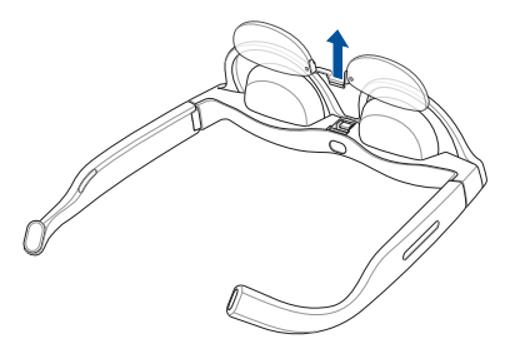Related Topics
- [Glasses]AirVision M1 Introduction to Wearable Display
- [Glasses]What safety precautions and maintenance methods should be followed when using glasses?
- [Smart Glasses] AirVision M1 Image-Related Issues
- [Smart Glasses] AirVision App Usage Tips
- [Smart Glasses] How to Update the AirVision M1 Firmware
- [Smart Glasses] Troubleshooting AirVision M1 Updates
[Smart Glasses] AirVision M1 Prescription Lens Guide
Q1: I have myopia (nearsightedness). Can I still use the AirVision glasses?
A1: Yes, you can. In the product packaging, we provide a frame/holder designed to accommodate prescription lenses. You should first obtain a prescription from your ophthalmologist or optometrist. Then, take the prescription and the prescription lens holder to an optician (eyeglass store) and inform them that these lenses will be used for AR glasses. They will create the lenses based on the provided holder. After that, you can install the lenses into the M1 glasses.

Q2: The optician is asking for the location of the optical center. Can you please use the image below to mark the center position so that customer service can provide it to the user for reference?
A2: The prescription lens holder will look like the image below, with a horizontal line. This line serves as the baseline for the pupil position.
The straight line represents the user's pupil position, so the optician should mark it based on the user's actual pupil position.
Q3: The frame screws are too long or difficult to install.
A3: Considering that high prescriptions often require thicker lenses, we've pre-allocated a longer screw length. After the lenses are fitted, the optician should shorten the screws as needed.
We recommend finding an optician with experience fitting rimless glasses.
Since these are rimless glasses, we recommend using lenses with a refractive index of 1.6 or higher.
Q4: How should I get prescription lenses fitted?
A4: The M1's image projection distance is approximately 3 meters. Based on user feedback, you should select lenses using the "infinity focus" setting. The key is to ensure that the pupillary distance (PD) of the lenses is configured based on the M1 and the user's individual measurements.
If the user has presbyopia (farsightedness):
Generally, when fitting glasses for users with presbyopia, a shorter focal distance is usually set. However, because the M1's image projection distance is farther, at approximately 3 meters, the optician should treat it like a regular nearsightedness correction and set the focus distance to infinity. This should resolve the user's blurry vision issue.